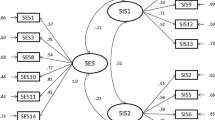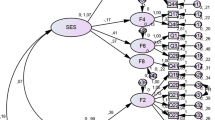Abstract
This article reports on the development of a new questionnaire designed to assess the propensity for sexual excitation and sexual inhibition in women: The Sexual Excitation/Sexual Inhibition Inventory for Women (SESII-W). The theoretical model underlying this research, the Dual Control Model, postulates that sexual response depends on a balance between excitatory and inhibitory mechanisms and that individuals vary in their propensity for excitation and inhibition. This study describes the development and initial validation of the SESII-W in a sample of 655 women (M age, 33.9 years). Factor analysis identified eight factors and two higher-order factors: one related to sexual excitation and one to sexual inhibition. The measure demonstrated good test-retest reliability and discriminant and convergent validity. Our data underscore that a number of factors affect women's sexual arousal and these appear to be related to opposing processes of sexual excitation and sexual inhibition. Theoretical issues, possible gender differences, and the value of using qualitative data to inform questionnaire development are discussed.

Similar content being viewed by others
References
American Psychiatric Association. (2000). Diagnostic and statistical manual of mental disorders (4th ed., text rev.). Washington, DC: Author.
Bancroft, J. (1999). Central inhibition of sexual response in the male: A theoretical perspective. Neuroscience and Biobehavioral Reviews, 23, 763–784.
Bancroft, J., Carnes, L., & Janssen, E. (2005). Unprotected anal intercourse in HIV-positive and HIV-negative gay men: The relevance of sexual arousability, mood, sensation seeking, and erectile problems. Archives of Sexual Behavior, 34, 299–305.
Bancroft, J., Carnes, J., Janssen, E. & Long, J. S. (2005). Erectile and ejaculatory problems in gay and heterosexual men. Archives of Sexual Behavior, 34, 285–297.
Bancroft, J., Herbenick, D., Barnes, T., Hallam-Jones, R., Wylie, K., Janssen, E., et al. (2005). The relevance of the dual control model to male sexual dysfunction: The Kinsey Institute/BASRT Collaborative Project. Sexual and Relationship Therapy, 20, 13–30.
Bancroft, J., & Janssen, E. (2000). The dual control model of male sexual response: A theoretical approach to centrally mediated erectile dysfunction. Neuroscience and Biobehavioral Reviews, 24, 571–579.
Bancroft, J., Janssen, E., Carnes, L., Strong, D. A., Goodrich, D., & Long, J. S. (2004). Sexual activity and risk taking in young heterosexual men: The relevance of personality factors. Journal of Sex Research, 41, 181–192.
Bancroft, J., Janssen, E., Strong, D., Carnes, L., & Long, J. S. (2003). Sexual risk taking in gay men: The relevance of sexual arousability, mood, and sensation seeking. Archives of Sexual Behavior, 32, 555–572.
Bancroft, J., Janssen, E., Strong, D., Carnes, L., Vukadinovic, Z., & Long, J. S. (2003). The relation between mood and sexuality in heterosexual men. Archives of Sexual Behavior, 32, 217–230.
Basson, R. (2000). The female sexual response: A different model. Journal of Sex and Marital Therapy, 26, 51–64.
Basson, R. (2002). A model of women's sexual arousal. Journal of Sex and Marital Therapy, 28, 1–10.
Bjorklund, D. F., & Kipp, K. (1996). Parental investment theory and gender differences in the evolution of inhibition mechanisms. Psychological Bulletin, 120, 163–188.
Byers, E. S. (2001). Evidence for the importance of relationship satisfaction for women's sexual functioning. In E. Kaschak & L. Tiefer (Eds.), A new view of women's sexual problems (pp. 23–26). New York: Haworth Press.
Carpenter, D. L., Janssen, E., Graham, C. A., Vorst, H., & Wicherts, J. (2006). Estimating the factor structure, reliability, and validity of women's scores on the Sexual Inhibition/Sexual Excitation Scales (SIS/SES). Manuscript submitted for publication.
Carver, C. S., & White, T. L. (1994). Behavioral inhibition, behavioral activation, and affective responses to impending reward and punishment: The BIS/BAS scales. Journal of Personality and Social Psychology, 67, 318–333.
Ellison, C. (2000). Women's sexualities. Oakland, CA: New Harbinger.
Everitt, B. S. (1975). Multivariate analysis: The need for data, and other problems. British Journal of Psychiatry, 126, 237–240.
Fine, M. (1988). Sexuality, schooling, and adolescent females: The missing discourse of desire. Harvard Educational Review, 29, 501–536.
Fisher, W. A. (1986). A psychological approach to human sexuality. In D. Byrne & K. K. Kelley (Eds.), Alternative approaches to human sexuality (pp. 131–171). Hillsdale, NJ: Erlbaum.
Fisher, W. A. (1998). The Sexual Opinion Survey. In C. M. Davis, W. L. Yarber, R. Bauserman, G. Scheer, & S. L. Davis (Eds.), Handbook of sexuality-related measures (pp. 218–223). Thousand Oaks, CA: Sage Publications.
Fisher, W. A., Byrne, D., White, L. A., & Kelley, K. (1988). Erotophobia-erotophilia as a dimension of personality. Journal of Sex Research, 25, 123–151.
Gaither, G. A., & Sellbom, M. (2003). The Sexual Sensation Seeking Scale: Reliability and validity within a heterosexual college student sample. Journal of Personality Assessment, 81, 157–167.
Graham, C. A., Sanders, S. A., Milhausen, R., & McBride, K. (2004). Turning on and turning off: A focus group study of the factors that affect women's sexual arousal. Archives of Sexual Behavior, 33, 527–538.
Hays, R. D., Hayashi, T., & Stewart, A. L. (1989). A five-item measure of socially desirable response set. Educational and Psychological Measurement, 49, 629–636.
Heiman, J. R. (2001). Sexual desire in human relationships. In W. Everaerd, E. Laan, & S. Both (Eds.), Sexual appetite, desire and motivation: Energetics of the sexual system (pp. 117–134). Amsterdam: Royal Netherlands Academy of Arts and Sciences.
Janssen, E., Vorst, H., Finn, P., & Bancroft, J. (2002a). The Sexual Inhibition (SIS) and Sexual Excitation (SES) Scales: I. Measuring sexual inhibition and excitation proneness in men. Journal of Sex Research, 39, 114–126.
Janssen, E., Vorst, H., Finn, P., & Bancroft, J. (2002b). The Sexual Inhibition (SIS) and Sexual Excitation (SES) Scales: II. Predicting psychophysiological response patterns. Journal of Sex Research, 39, 127–132.
Kalichman, S. C., & Rompa, D. (1995). Sexual Sensation Seeking and Sexual Compulsivity Scales: Reliability, validity, and predicting HIV-risk behavior. Journal of Personality Assessment, 65, 586–601.
Lawrance, K., & Byers, E. S. (1995). Sexual satisfaction in long-term heterosexual relationships: The interpersonal exchange model of sexual satisfaction. Journal of Social and Personal Relationships, 15, 257–267.
Lykins, A., Janssen, E., & Graham, C. A. (in press). The relationship between negative mood and sexuality in heterosexual college women. Journal of Sex Research.
MacCallum, R. C., Widaman, K. F., Zhang, S., & Hong, S. (1999). Sample size in factor analysis. Psychological Methods, 4, 84–99.
Milhausen, R. R., Sanders, S. A., & Graham, C. A. (2006). Factors that inhibit and enhance sexual arousal in college men and women. Manuscript in preparation.
Sprecher, S. & Regan, P. C. (1996). College virgins: How men and women perceive their sexual selves. Journal of Sex Research, 33, 3–15.
Tabachnick, B. G., & Fidell, L. S. (2001). Using multivariate statistics (4th ed.). Needham Heights, MA: Allyn and Bacon.
Taylor, J. F., Rosen, R. C., & Leiblum, S. R. (1994). Self-report assessment of female sexual function: Psychometric evaluation of the brief index of sexual functioning for women. Archives of Sexual Behavior, 23, 627–643.
The Working Group for a New View of Women's Sexual Problems. (2001). A new view of women's sexual problems. In E. Kaschak & L. Tiefer (Eds.), A new view of women's sexual problems (pp. 1–8). New York: Haworth Press.
Tiefer, L. (2001a). General discussion. In J. Bancroft (Ed.), The role of theory in sex research (pp. 235–236). Bloomington: Indiana University Press.
Tiefer, L. (2001b). Arriving at a ‘new view’ of women's sexual problems: Background, theory, and activism. In E. Kaschak & L. Tiefer (Eds.), A new view of women's sexual problems (pp. 63–98). New York: Haworth Press.
Tolman, D. (2002). Dilemmas of desire: Teenage girls and sexuality. Cambridge MA: Harvard University Press.
Vogt, D. S., King, D. W., & King, L. A. (2004). Focus groups in psychological assessment: Enhancing content validity by consulting members of the target population. Psychological Assessment, 16, 231–243.
Acknowledgments
This study was funded, in part, by a grant from the Lilly Centre for Women's Health. We would like to thank Kimberly McBride for help with questionnaire item development and recruitment, Alison Larkin for research assistance, Scott Long for statistical advice, and John Bancroft and Erick Janssen for helpful discussions and comments on a draft of the paper.
Author information
Authors and Affiliations
Corresponding author
Rights and permissions
About this article
Cite this article
Graham, C.A., Sanders, S.A. & Milhausen, R.R. The Sexual Excitation/Sexual Inhibition Inventory for Women: Psychometric Properties. Arch Sex Behav 35, 397–409 (2006). https://doi.org/10.1007/s10508-006-9041-7
Received:
Revised:
Accepted:
Published:
Issue Date:
DOI: https://doi.org/10.1007/s10508-006-9041-7




